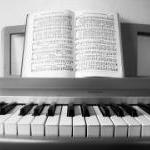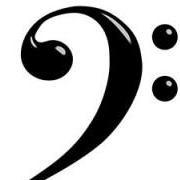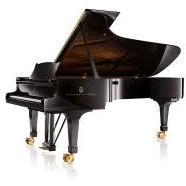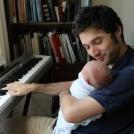Search the Community
Showing results for tags 'rondo'.
-
Working on a 5 part rondo piece These are the key areas I'm thinking of going with -- Bb -> Db -> Bb -> G (with some modal mixture from gm) -> Bb - For my modulation to Db, I took some jazz inspiration, and used my Bb in the flute melody to make an Ab9 chord (V7 in Db), and then a CT dim7 chord before landing on the tonic, but that transition could be smoother. I'm going to use that same chord as a Tritone Sub (or a bII - almost a Neopolotian 6th) to modulate to G Major. - I feel like my melody sounds too "rigid" if that makes sense; I almost always start with my harmonic progressions and after I get all that figured out is when I go back and write a melody to match or compliment it. I would appreciate your feedback - thanks in advance!
-
Good evening everyone! I'm excited to present a new piece I have been working on for the last month or so: Scherzo for Orchestra. I deliberately wrote this fairly quickly, with the intent to write something fun, conventional, and maybe even a little whimsical. I'm interested in any and all constructive feedback. I had a few goals in mind as I composed this, feel free to critique my success or failure on these: Write something a little more informal and accessible, with catchy, memorable themes. Start with a very simple idea, and build the entire piece off of it. The four bar opening phrase in the 2nd violins popped into my head one day, so I tried to build the entire piece off of this motive and transformations of this motive. Practice having multiple contrapuntal lines. Some details on this are below. Write something that would work as a middle movement of a larger work, such as a symphony. Write something under 10 minutes, since I might decide to enter it into a competition and a lot of competitions have a 10 minute time limit. The piece is loosely structured in a three-part rondo form (ABACABA). (0:00 - 1:32) - A Theme - A very quick staccato theme in C# minor. I based this on the idea of a fugue, with each voice entering at different scale degrees, before they all come together to cadence. I'm sure I broke a few rules on the counterpoint, but it got the job done. The section ends on the V (G# minor) (1:32 - 2:21) - B Theme - A soaring theme in E major, then restated in Db major. Here I tried to have descending chromatic lines to complement the ascending melody. (2:21 - 3:04) - A Theme - Restatement of the second half of the A Theme, this time ending on I (C# minor) (3:04 - 6:31) - C Theme - A waltz in D major that begins very timid, gradually gains confidence, and goes out with a bang. (6:31 - 8:01) - A Theme - Restatement of the A Theme, this time in D minor, with the orchestration modified slightly. I threw in a couple unprepared modulations up a half step, to Eb minor and E minor. As a result I may have broken a "rule" here since I ended the section on B minor (which is not the V of D minor, the key I eventually return to). (8:01 - 8:49) - B Theme - Restatement of the B Theme, this time in Db major and Bb major. (8:49 - 9:37) - A Theme - The second half of the A Theme again, eventually returning to D minor to end the piece. As usual, I have an onslaught of questions I would like specific feedback on. Feel free to answer as many or as few as you wish: What effect does the music have on you? Does in conjure up an image? Or an emotional feeling? Does it tell you a story? This can be the piece as a whole, or a specific part or parts. What was your favorite part? What was your least favorite part? Do you have any comments or critiques on technique, e.g. harmony, melody writing, counterpoint, orchestration, voice-leading, etc.? How do you feel about the overall form? Is it effective? Do any of the parts seem impractical to you? It's a pretty fast piece with a lot of technique, so I'm curious if some of the parts are impractical. I don't mind them being difficult, I would only be concerned if they are borderline impossible. Do you have any comments of the quality of the performance in the audio file? I really want this to be a decent representation of how the piece would sound if it were performed live, since it is unlikely it ever will be. Feel free to put your "conductor hat" on and critique the "orchestra". I have included a score and welcome any constructive feedback on its presentation. And if you're like me it's a lot more fun to follow along with the score. Are there any composers this reminds you of, that I might enjoy listening to? Sound libraries: Spitfire Symphonic Orchestra and Spitfire Percussion VSL Trumpet (only for some of the lyrical trumpet melodies) VSL Violins (only to layer with the violins in Spitfire) Thanks for listening, I hope you enjoy! If you liked something I did and want me to explain how I did it, feel free to ask as well. -gmm
- 20 replies
-
- 9
-

-
- counterpoint
- scherzo
-
(and 2 more)
Tagged with:
-
This is the part 4 ofSound of Queanbeyan.
-
A piece that a friend commissioned me to write. just a simple waltz that I wrote in a day. It's repetitive and relatively simple but yeah I hope you enjoy. It's in rondo form and is essentially me trying to be as unoriginal as possible and I think it is one of my best especially as I didn't think too much about it.
-
Well, this is a rondo that I composed some time ago. I know the last measures are almost impossible to play, i will nerf them later. Any comment is apreciated :3..
-
Hello everyone, I am back, this is my new piece, hope your commentation.
- 2 replies
-
- piano quintet
- original
-
(and 4 more)
Tagged with:
-
What do you think of my composition?
- 2 replies
-
- strings
- string orchestra
-
(and 2 more)
Tagged with:
-
A little piano piece that I wrote. Hope you enjoy!
-
8 Pieces for Solo Piano 1. Prelude 2. March 3. Minuet 4. Dance 5. Ecossais 6. Gavotte 7. Allegro 8. Rondo Sorry, they're all separate files
-
this is the piece I newly composed, hope everyone like it.
-
This is the piece I newly composed, hope everyone like it, and @Monarcheon welcome your commentation.
-
This is the piece I newly composed, hope everyone like it and comment on it.
-
This little piece uses different contemporary techniques such us random dynamics, interval set, dodecaphonic scales, etc..., in a counterpoint background including canon (octava, motu contrario, prolation).
- 2 replies
-
- rondo
- pitch class set
-
(and 4 more)
Tagged with:
-
This is my rondo in Bflat from my violin sonata. This piece is about the secret crush I had on my first music theory teacher, whose name was Meredith. I don't know where she is now, but this is my ode to our love. This is my first time sharing some of my music on this site. Thank you in advance to those of you who take a listen! The rondo is in ABACAB form, with a coda at the end.
- 4 replies
-
- violin sonata
- piano
-
(and 2 more)
Tagged with:
-
This is my first sonata, it has two movements. In first, I played with the esthetic of minimalism, and in the second I clashed few different styles in rondo-like form to get some comic but still captivating effect. Feel free to give any comment, advice, suggestion :)
-
I composed this little rondo for solo piano. It has intentionally simplistic harmony and starts quietly and plainly, but by the end it's fiery and dramatic. It is in the form A-B-A-C-A-Coda.
-
This one is I newly composed, hope you like it.
- 2 replies
-
- 1
-

-
- piano solo
- classical
-
(and 2 more)
Tagged with:
-
These are my other two piano solos composed recently, wish you like them. And @Monarcheon, welcome your commentation.
-
This is a rondo in g major written for viola and piano. The score is still a little messy, so apologies for that in advance. Hope you enjoy!









